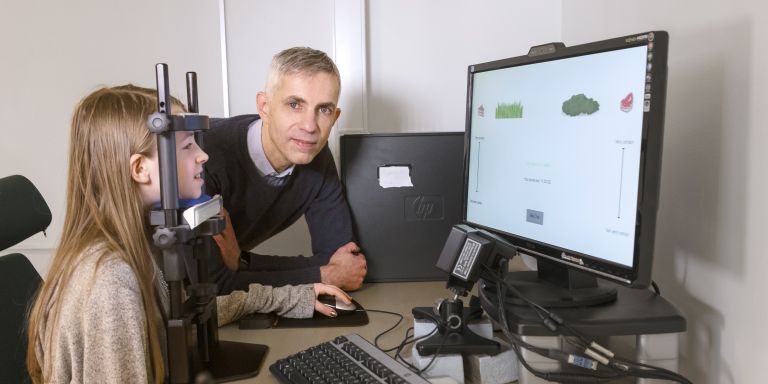
Erik Domellöf
Associate Professor of Psychology
Wallenberg Academy Fellow, prolongation grant 2020
Institution:
Umeå University
Research field:
Motor planning skills in children


Wallenberg Academy Fellow, prolongation grant 2020
Institution:
Umeå University
Research field:
Motor planning skills in children
Many of our bodily movements are the result of interaction between eye and hand, and activation of a specific part of the brain involved in the decisions we make. We know what we are going to do before we do it.
Recent research has shown that children on the autism spectrum may be less able to plan their movements. Domellöf, who is a psychologist, believes this may explain their motor problems. But no detailed studies have been made of what happens in different parts of the brain as we plan a movement.
“Better knowledge of child motor development is needed for diagnostic purposes and so the right treatment can be prescribed,” says Domellöf.
Domellöf’s research on the ability to prepare and carry out movements began after he had been chosen as a Wallenberg Academy Fellow in 2015. The project has now been extended for a further five years.
He began by building a studio with special cameras to record movements of participants who are instructed to perform certain tasks at a table.
The first study was confined to people who had not been diagnosed with any condition. The participants were a group of six-year-olds and a group of ten-year-olds. A third group comprised adults. Everyone had the same task to complete. They had to lift up a stick, rotate it and then put it down in a specific place.
The results revealed differences in planning as well as performance.
“Younger children in particular picked up the stick and took it straight to where it was to be placed before they thought about what to do next. Their movements were therefore not very well planned. The adults performed the movements a little more slowly, but more efficiently than the children. They planned the whole sequence of movements right from the outset.”
The six-year-olds were compared with a group of children the same age but with autism spectrum conditions.
“Children with autism did not rotate the stick as much while they carried it, which indicated poorer planning. There was also a much clearer distinction between their movements.”
The same children also exhibited pronounced differences from one experiment to another.
“It appears that children with autism do not remember which strategies were successful.”
Many of our day-to-day movements can be broken down into multiple sequences. We look at the glass before we take hold of it to drink and then put it back down. Our eyes home in on the target before the movement begins, supporting both planning and control.
“Eye-hand coordination is vital. But the world around us is often highly complex and full of information that challenges our sensory system. The planning, timing and precision of our eye movements are critical as we scan our surroundings to decide what to focus on.”
The ability of children with autism spectrum conditions to follow an object with their eyes may be impaired.
“Perhaps children with autism find it more difficult to tie their shoelaces and button up garments not because of mechanical difficulties, but because of problems with planning.”
Domellöf also wants to ascertain whether the brain’s mirror neuron system is activated differently in children with autism. Mirror neurons are nerve cells that produce impulses not only when we perform an action but also when we see someone else do the same thing.
“If children with autism have an impaired mirror neuron system, it may explain their problems in understanding the actions of others, which in turn impacts social interaction.”
The project was initially hampered by major problems with the technology.
“The first equipment we bought wasn’t able to synchronize recorded eye movements with recorded hand movements. We’re now collaborating with a Swedish company that has resolved all our technical problems. Fortunately, we were able to use data from the hand movements, but not from the eye movements.”
“I’m delighted and honored to have had my Fellow grant extended. It will enable me to continue studying the ability of children and youth with autism to predict impending events as compared with the ability of their neurotypical peers.”
The study was also delayed by interruptions during the coronavirus pandemic.
“That’s the way it is with research projects sometimes. You can’t give up just because you run into obstacles; you have to try to resolve the situation as best you can. It takes time to establish a laboratory.”
The most innovative aspect of the study is being carried out with the help of functional Magnetic Resonance Imaging (fMRI). This is a non-invasive method of measuring brain activity in a person while they are considering how to solve a problem, for instance. The equipment resembles a magnetic field where the participant lies.
Domellöf sees it as a high-risk undertaking to study motor skills in an fMRI scanner, since there is limited space, and movements can affect image quality. The participants are therefore asked to perform “miniature movements”.
“We’ll be able to see for the first time what happens in the brain of a child when it performs a movement requiring planning. We’re also interested in fluctuations in activity in different parts of the brain when a child watches someone else performing the same movement.”
There are also plans to study eye movements when a participant performs a task similar to a computer game on a screen in the scanner.
“Studies that document the relationship between bodily movements and simultaneous brain imaging are highly unusual. Our findings will add to knowledge in this field.”
Text Carin Mannberg-Zackari
Translation Maxwell Arding
Photo Mattias Pettersson